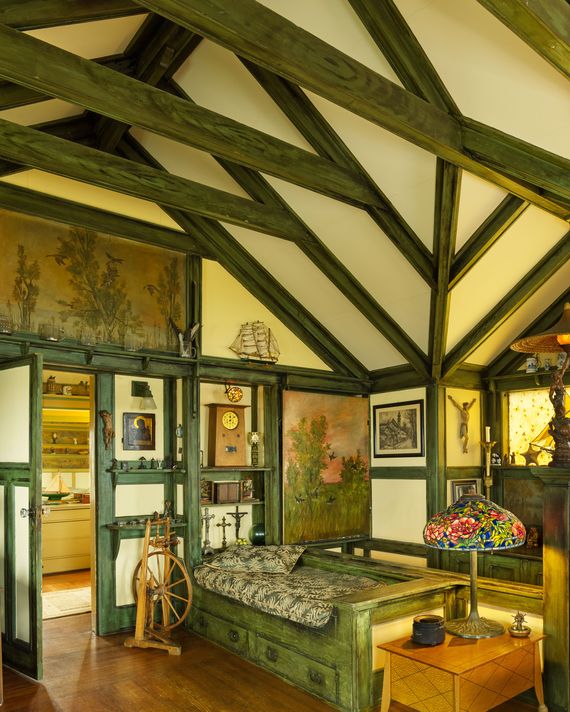
The house sits on one of the lowest elevations in the Rockaways,” says Patrick Clark, who bought the 19th-century shingled cottage in 1998. He soon realized, among other things, that it had to be raised in order to avoid being flooded every month with the new moon, which sends about 16 inches of water from the bay across the street.
Clark is a stained-glass artisan, and he has scrupulously restored and preserved the house, which bears a discreet plaque on one side that reads THE RICHARD MOTT HOUSE C. 1880 A HISTORIC ARTIST’S COTTAGE IN THE BOROUGH OF QUEENS, NEW YORK CITY. Inside, it feels like you’re in a 19th-century seafaring vessel.
The previous owner had been something of a hoarder, and the house was a wreck when he bought it. The wood on the ground floor was completely gone, and only cracked concrete slabs remained. “I had to open the walls, cut out rotted studs, and laminate/sandwich studs with new support studs,” he says. Since the ceiling was so low on the first floor, “I decided to add ten inches to its height.”
Clark not only repaired the interior damage but also raised the building eight feet off the ground in 2001, shoring up a new foundation and then raising the lot’s ground level three feet. “It took 30 semi-truckloads of dirt fill to get the yard up out of the high-tide water,” Clark says. The complex renovation went on for years, all done with the help of his meticulous stained-glass crew.
Clark’s father, a nuclear engineer who worked on the Manhattan Project, was stationed in Vienna in 1968. This had a great influence on his son, who roamed the Austrian countryside with his friends, exploring abandoned mansions with stained-glass windows and other neglected treasures.
In time, Clark learned the art of making stained glass. By 1986, he was in New York, creating and repairing stained-glass windows for clients — including St. Patrick’s Cathedral. The brother of one client first introduced Clark to this house and to its owner, whom he would visit on a regular basis. Then, in 1998, circumstances conspired to enable him to buy the property that he says he felt “had been waiting for me.”
The entrance hall opens to the original stair, and a small room with the original coal-burning stove is off to one side. The dining room beyond is furnished with a large table Clark made from turn-of-the-last-century oak pews from Holy Name of Jesus Church’s lower chapel, on Amsterdam and 96th Street, where he worked restoring the stained-glass windows in 1998. The medieval-looking chairs are reincarnated designs Clark made from the circa-1914 oak pews of St. Jean Baptiste Church at Lexington and 76th Street, from which he salvaged the full-length pews when the altar area was expanded.
Mott actually lived elsewhere, in an 1850s mansion on 25th Street in Bayswater, Queens, but it, like “many other great historic homes in the area, has been demolished in the last 20 years for new crap construction,” Clark says. Which makes his restored cottage among the only historic houses left.
*A version of this article appears in the December 7, 2020, issue of New York Magazine. Subscribe Now!














